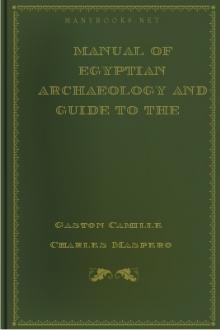Ancient America, in Notes on American Archaeology by John D. Baldwin (best thriller books to read .TXT) 📕

"It is in the form of a serpent, upward of 1000 feet in length, extended i
Read free book «Ancient America, in Notes on American Archaeology by John D. Baldwin (best thriller books to read .TXT) 📕» - read online or download for free at americanlibrarybooks.com
- Author: John D. Baldwin
- Performer: -
Read book online «Ancient America, in Notes on American Archaeology by John D. Baldwin (best thriller books to read .TXT) 📕». Author - John D. Baldwin
It is 43 feet long by 23 deep, and stands on a platform 62 feet long by 55 wide. It was ornamented above the cornice, but the decorations are much defaced by decay. A stone tablet extending the whole length of the back wall, inside, is covered by an inscription.
A remarkable structure is found at this place, which Mr. Stephens called the “Gymnasium, or Tennis Court.” It consists of two immense parallel walls 274 feet long, 30 thick, and 120 apart. On elevations facing the two ends of the open space between them, 100 feet from the ends of the walls, stand two edifices much ruined, but showing, in their remains, that they were richly ornamented. Midway in the length of the walls, facing each other, and 20 feet above the ground, are two massive stone rings or circles 4 feet in diameter, each having in the centre a hole 1 foot and 7 inches in diameter. On the borders around these holes two entwined serpents are sculptured, as seen in Figure 43.
There was a similar structure in the old city of Mexico, and remains of one like it are found at Mayapan. They were, probably, used for games of some kind. Among the other ruins at Chichen-Itza are the remains of a lofty edifice which has two high ranges or stories. On the outside the ornamentation is simple and tasteful, but the walls of its chambers are very elaborately decorated, mostly with sculptured designs, which seem to have been painted. In one of the upper rooms Mr. Stephens found a beam of sapote wood used as a lintel, which was covered with very elegantly carved decorations. The walls of this room were covered, from the bottom to the top of the arched ceiling, with painted designs similar to those seen in the Mexican “picture writing.” Decay had mutilated these “pictures,” but the colors were still bright. There are indications that painting was generally used by the aboriginal builders, even on their sculptures. The colors seen in this room were green, red, yellow, blue, and reddish-brown. Another edifice, standing on a high mound, is reached by means of the usual great stairway, which begins at the bottom, with a sort of balustrade on each side, the ends of which are stone figures of heads of immense serpents.
Not far from this is a singular ruin, consisting of groups of small columns standing in rows five abreast, the tallest being not more than six feet high. Many of them have fallen. It is impossible to determine how they were used, or what they mean.
OTHER RUINS IN YUCATAN.Izamal, Labna, Zayi, and some of the other ruins are sufficiently important for special notice; but they present every where the same characteristics, differing a little in the style or method of ornamentation. At Labna there is among the ruins an ancient gateway, beautiful in design and construction, a view of which is given in the Frontispiece. The best account of some of the other ruins on this peninsula can be found in the volumes of Mr. Stephens, entitled “Incidents of Travel in Yucatan.” At Zayi there is a singular building, which, as seen at a distance by Mr. Stephens, “had the appearance of a New England factory.” But what seemed to be a “factory” is, in fact, nothing more than a massive wall with oblong openings, which runs along the middle of the roof, and rises thirty feet above it. The building was below this wall, but the front part of it had fallen. Among the remains at Xcoch is the great mound represented in Figure 44.
There is a remarkable ruin at Ake, at the south, which deserves mention. Here, on the summit of a great mound, very level, and 225 feet by 50 in extent, stand 36 shafts or columns, in three parallel rows. The columns are about 15 feet high and 4 feet square. The ruins of Ake, which cover a great space, are ruder and more massive than most of the others. The island of Cozumel and the adjacent coast of Yucatan were populous when the Spaniards first went there, but the great towns then inhabited are now in ruins.
Water is scarce on this peninsula, and a sufficient supply is not obtained without considerable difficulty. The ancient inhabitants provided for this lack of water by constructing aguadas or artificial ponds. These, or many of them, doubtless, are as old as the oldest of the ruined cities. Intelligence, much skill in masonry, and much labor were required to construct them. They were paved with several courses of stone laid in cement, and in their bottoms wells or cavities were constructed. More than forty such wells were found in the bottom of one of these aguadas at Galal, which has been repaired and restored to use. A section of the bottom of this aguada is shown in Figure 45. In some places long subterranean passages lead down to pools of water, which are used in the dry season. One of these subterranean reservoirs, and the cavernous passage leading to it, are shown in Figure 46. The reservoir is 450 feet below the surface of the ground, and the passage leading to it is about 1400 feet long. Branching passages, not shown, lead to two or three other basins of water.
The wooden lintels, which are common in Yucatan, do not appear in the other ruins, and there is a difference in the style of ornamentation between those at Palenque or Copan, for instance, and those at Uxmal, but every where the architecture is regulated by the same idea, the differences indicating nothing more than different periods and different phases of development in the history of the same people.
Some of the great edifices in these old ruins, such as the “Palace” at Palenque, and the “Casa del Gobernador” at Uxmal, remind us of the “communal buildings” of the Pueblos, and yet there is a wide difference between them. They are not alike either in character or purpose, although such great buildings as the “Palace” may have been designed for the occupation of several families. There is no indication that “communal” residences were ever common in this part of the country. At the time of the Conquest the houses of the people were ordinary family dwellings, made of wood, and we may reasonably suppose this fashion of building was handed down from the earlier ages. Herrera, who supposed, mistakenly, that all the great stone edifices were temples, said, in his account of Yucatan, “There were so many and such stately stone buildings that it was amazing; and the greatest wonder was that, having no use of any metal, they were able to raise such structures, which seem to have been temples; for their houses were all of timber, and thatched.” But they had the use of metals, and they had the art of making some of them admirable for use in cutting stone and carving wood.
Among the buildings of later date are some of those on the western coast, which were still inhabited three hundred and fifty years ago. The city of Tuloom was inhabited then. Figure 47 shows a ground plan of the walls of this city, with the position of some of the ruined monuments.
Within the walls are remains of finely constructed buildings on elevated foundations, none of them, however, very large. One of them had a wooden roof, and timber seems to have been considerably used here. The walls still standing were made of hewn stone. Remains of stone edifices exist all along this coast, but the whole region is now covered by a dense growth of trees and other vegetation. Tuloom was seen in 1518 by Grijalva, who sailed along the coast. At that time the island of Cozumel, where noteworthy ruins are found, was inhabited by many people. Figure 48 shows one of the watch-towers on the walls of Tuloom.
VI.ANTIQUITY OF THE RUINS.
The Mexican and Central American ruins make it certain that in ancient times an important civilization existed in that part of the continent, which must have begun at a remote period in the past. If they have any significance, this must be accepted as an ascertained fact. A large proportion of them had been forgotten in the forests, or become mythical and mysterious, long before the arrival of the Spaniards.
In 1520, three hundred and fifty years ago, the forest which so largely covers Yucatan, Guatemala, and Chiapa was growing as it grows now; yes, four hundred and fifty years ago, for it was there a century previous to this date, when, the Maya kingdom being broken up, one of its princes fled into this forest with a portion of his people, the Itzas, and settled at Lake Peten. It was the same then as now. How many additional centuries it had existed no one can tell. If its age could be told, it would still be necessary to consider that the ruins hidden in it are much older than the forest, and that the period of civilization they represent closed long before it was established.
In the ages previous to the beginning of this immense forest, the region it covers was the seat of a civilization which grew up to a high degree of development, flourished a long time, and finally declined, until its cities were deserted, and its cultivated fields left to the wild influences of nature. It may be safely assumed that both the forest-covered ruins and the forest itself are far older than the Aztec period; but who can tell how much older? Copan, first discovered and described three hundred years ago, was then as strange to the natives dwelling near it as the old Chaldean ruins are to the Arabs who wander over the wasted plains of Lower Mesopotamia. Native tradition had forgotten its history and become silent in regard to it. How long had ruined Copan been in this condition? No one can tell. Manifestly it was forgotten, left buried in the forest without recollection of its history, long before Montezuma’s people, the Aztecs, rose to power; and it is easily understood that this old city had an important history previous to that unknown time in the past when war, revolution, or some other agency of destruction put an end to its career and left it to become what it is now.
Moreover, these old ruins, in all cases, show us only the cities last occupied in the periods to which they belong. Doubtless others still older preceded them; and, besides, it can be seen that some of the ruined cities which can now be traced were several times renewed by reconstructions. We must consider, also, that





Comments (0)